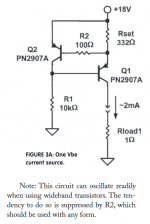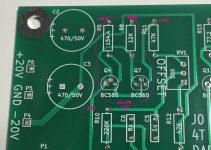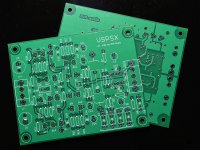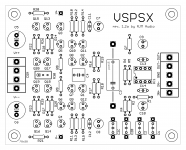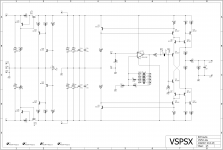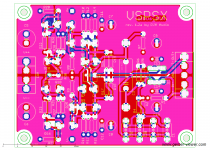Good on ya. With an open mind you tried it out for yourself, got results you find conclusive, drew a conclusion, and moved on.
I remain a little disturbed, myself. I find it disconcerting that I observed and took pictures of oscillation using BC560 transistors, in two completely different setups: (i) on a 2 layer PCB, and (ii) on a solderless breadboard. I also find it a little disturbing that I tried eight different transistor part#s in the solderless breadboard, and observed oscillation with four of the eight. The breadboard might or might not have encouraged oscillation but it certainly didn't guarantee oscillation; the transistors themselves need to have certain (unknown by me!) characteristics for the circuit to oscillate. Walt Jung's article Sources 101 (excerpt below) suggests that characteristic might be "wideband" but the table attached to post #37 in this thread seems to say otherwise. So I remain a little disturbed. Glad to hear you are not.
Mark Johnson
_
I remain a little disturbed, myself. I find it disconcerting that I observed and took pictures of oscillation using BC560 transistors, in two completely different setups: (i) on a 2 layer PCB, and (ii) on a solderless breadboard. I also find it a little disturbing that I tried eight different transistor part#s in the solderless breadboard, and observed oscillation with four of the eight. The breadboard might or might not have encouraged oscillation but it certainly didn't guarantee oscillation; the transistors themselves need to have certain (unknown by me!) characteristics for the circuit to oscillate. Walt Jung's article Sources 101 (excerpt below) suggests that characteristic might be "wideband" but the table attached to post #37 in this thread seems to say otherwise. So I remain a little disturbed. Glad to hear you are not.
Mark Johnson
_
Attachments
My results only extend to my own circuit, with two BC327s and the values shown in the layout used.
Maybe having the transistors further apart as you had, maybe an oddity of your measurement arrangement. That you have the issue with multiple configurations and parts suggests something to do with the setup / test itself rather than the parts used.
On the other hand if I read your plot in #32 correctly the oscillation frequency you observe is ~~ns so 100 Mhz or perhaps more. (what was it exactly?) That's actually above the bandwidth of my 20 Mhz 'scope so I can't comment, except to note that at those frequencies the effect of the test leads can be significant.
Maybe having the transistors further apart as you had, maybe an oddity of your measurement arrangement. That you have the issue with multiple configurations and parts suggests something to do with the setup / test itself rather than the parts used.
On the other hand if I read your plot in #32 correctly the oscillation frequency you observe is ~~ns so 100 Mhz or perhaps more. (what was it exactly?) That's actually above the bandwidth of my 20 Mhz 'scope so I can't comment, except to note that at those frequencies the effect of the test leads can be significant.
The same circuit with the same component values, oscillates on a 2 layer PCB. Photo below. Consider it a second, independent test setup.
SPICE simulations are underway and they seem to be indicating which pieces of the circuit have the greatest influence upon oscillation. Maybe something definitive might pop out eventually, who knows.
SPICE simulations are underway and they seem to be indicating which pieces of the circuit have the greatest influence upon oscillation. Maybe something definitive might pop out eventually, who knows.
Attachments
Other than the absence of a ceramic bypass on Vcc close to Q7 I'd give it a clean bill of health.
Hi Richard
I finallly completed the VSPSX, I simply squeezed in the MKS in 5 mm package, it fits with bent feet. I used shielded two-core cable for audio in and out, twisted the voltage aupply cables and have vortually no hum. I haven't listened to music with it yet, but I tested it with a wave generator today. The output looks nice and clean in the oscilloscope and I saw no signs of oscillation or hum. Also tested a wide range of input voltages, it seems to be distortion-free up to ca 150 mV input. As I am doing this as a first-timer, which impedance would you suggest as a load for the output for measuring?
Cheers
Jakob
I finallly completed the VSPSX, I simply squeezed in the MKS in 5 mm package, it fits with bent feet. I used shielded two-core cable for audio in and out, twisted the voltage aupply cables and have vortually no hum. I haven't listened to music with it yet, but I tested it with a wave generator today. The output looks nice and clean in the oscilloscope and I saw no signs of oscillation or hum. Also tested a wide range of input voltages, it seems to be distortion-free up to ca 150 mV input. As I am doing this as a first-timer, which impedance would you suggest as a load for the output for measuring?
Cheers
Jakob
yeah ... sorry about C4, it's a bit of a squeeze.
The VSPSX already has 75k on the output, the extra external load of 25-100k won't make much difference to the measurements.
As long as the static voltages measure correctly there is no real need to look at the dynamic response though if you can do a distortion check all the better I guess ... I'd check the output noise FFT with a dummy load of 500 ohms or so on the input, but really the main thing by that point is how it sounds not how it measures.
The VSPSX already has 75k on the output, the extra external load of 25-100k won't make much difference to the measurements.
As long as the static voltages measure correctly there is no real need to look at the dynamic response though if you can do a distortion check all the better I guess ... I'd check the output noise FFT with a dummy load of 500 ohms or so on the input, but really the main thing by that point is how it sounds not how it measures.
Hi,
I decided to switch off the measuring equipment I borrowed from my father-in-law and I listened to music with the VSPSX all night tonight, and it produces the music very nicely and much to my pleasure.
Overall it sounds a lot cleaner than the built-in phono amps of my (close-to-30-years-old) NAD 304 and Denon PMA 980R amplifiers. No touch of "colouring" the sound, no added warmth, coolness, fuzziness, or sharpness. My feeling is that I get more detail than I was used to, but then it may also be due to my expectation to hear something different from before. Most importantly: it works a treat and even board rev. 1.0a was nice to build. I cannot comment on the oscillation issue, but I do not have experienced any issues.
Possibly correlated to my building skills rather than to the design of the circuit: I already get very little hum at volumes higher than normal listening volume if I leave the ground connection of my turntable unconnected and the hum is completely eliminated if it is connected. So that part worked out very nicely for me.
Thanks a bunch!
Jakob
I decided to switch off the measuring equipment I borrowed from my father-in-law and I listened to music with the VSPSX all night tonight, and it produces the music very nicely and much to my pleasure.
Overall it sounds a lot cleaner than the built-in phono amps of my (close-to-30-years-old) NAD 304 and Denon PMA 980R amplifiers. No touch of "colouring" the sound, no added warmth, coolness, fuzziness, or sharpness. My feeling is that I get more detail than I was used to, but then it may also be due to my expectation to hear something different from before. Most importantly: it works a treat and even board rev. 1.0a was nice to build. I cannot comment on the oscillation issue, but I do not have experienced any issues.
Possibly correlated to my building skills rather than to the design of the circuit: I already get very little hum at volumes higher than normal listening volume if I leave the ground connection of my turntable unconnected and the hum is completely eliminated if it is connected. So that part worked out very nicely for me.
Thanks a bunch!
Jakob
Thanks for the report. The turntable ground should always be connected to the phono stage, it is normal for hum to be heard otherwise. If there is no hum with it connected to the VSPSX then the VSPSX is working as it should.
There never an oscillation issue with the VSPSX, just ripple/hum, I was worried that the regulator circuit did not work as designed but it seems - from your work and elsewhere - that this fear was unfounded.
I'm glad the VSPSX is all right, and by extension the S-Reg, but the VSPSX will not be developed further. Too complex to ever achieve any kind of popularity. I will however revise it to fix C4 package and post the Gerber file to this thread.
There never an oscillation issue with the VSPSX, just ripple/hum, I was worried that the regulator circuit did not work as designed but it seems - from your work and elsewhere - that this fear was unfounded.
I'm glad the VSPSX is all right, and by extension the S-Reg, but the VSPSX will not be developed further. Too complex to ever achieve any kind of popularity. I will however revise it to fix C4 package and post the Gerber file to this thread.
vspsx 1.2a
removed some capacitors to get some workspace, and did a general clean&tidy
removed some capacitors to get some workspace, and did a general clean&tidy
Attachments
Hi RMJ,
Your level of skill is admirable. Im thinking of putting together a design thats also a single gain stage + buffer and was wondering if you considered putting the buffer inside the feedback loop in your design, and if an lpf after the opamp like in your emerald phono also can be benefitial with vsps.
Regards, jin
Your level of skill is admirable. Im thinking of putting together a design thats also a single gain stage + buffer and was wondering if you considered putting the buffer inside the feedback loop in your design, and if an lpf after the opamp like in your emerald phono also can be benefitial with vsps.
Regards, jin
- Home
- Source & Line
- Analogue Source
- VSPSX very simple phono stage + x
